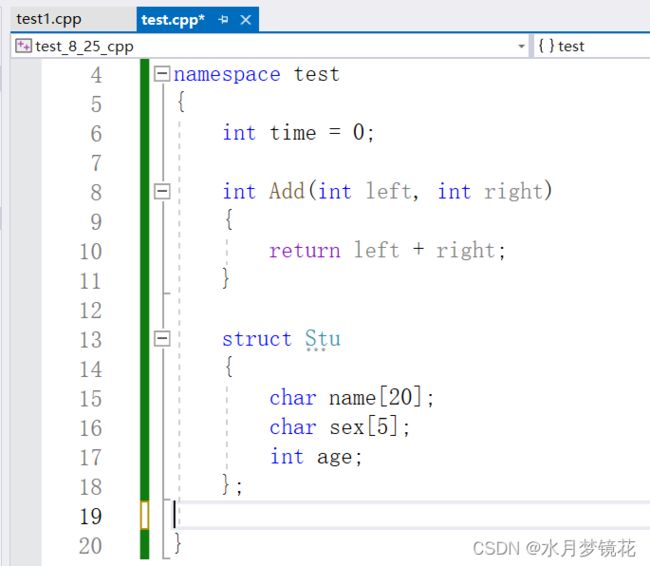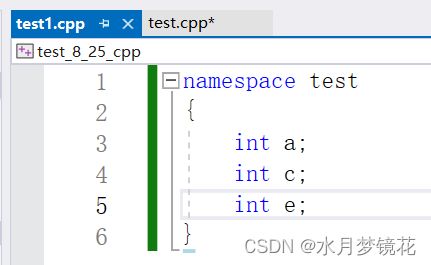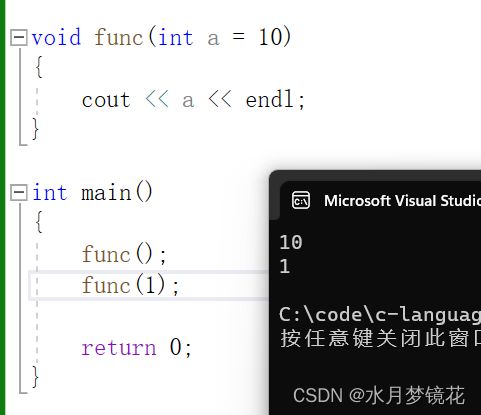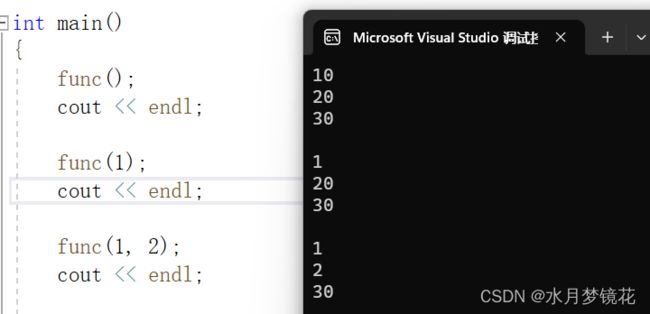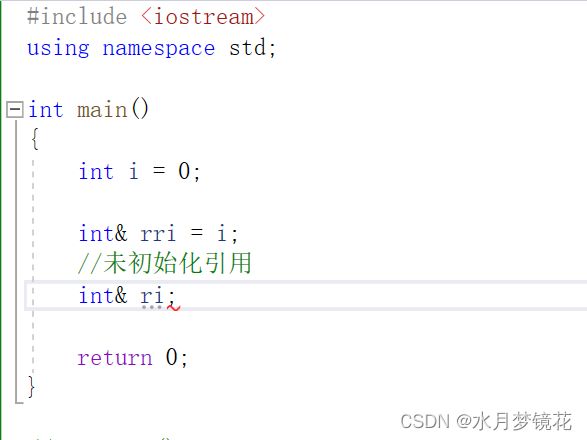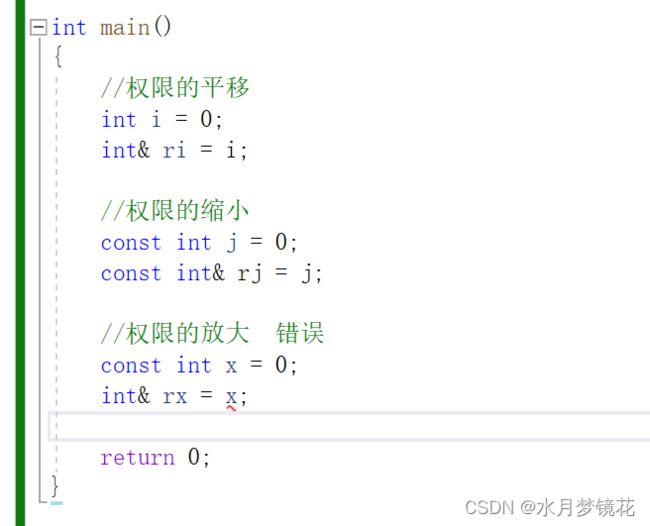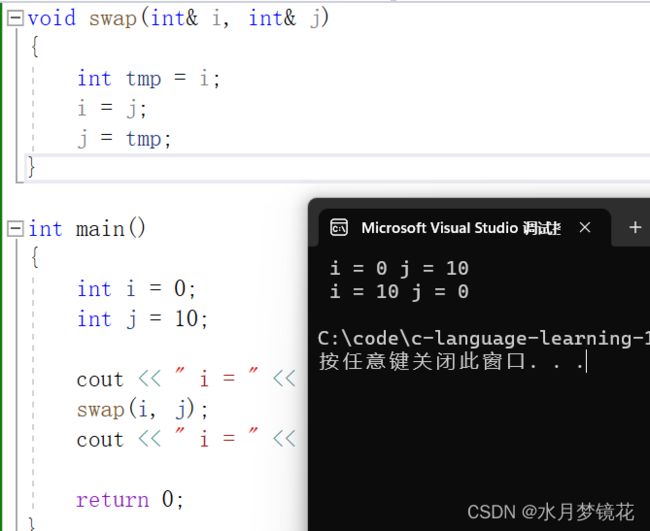C++:命名空间,缺省参数,函数重载,引用,内联函数
![]()
个人主页 : 个人主页
个人专栏 : 《数据结构》 《C语言》《C++》
文章目录
- 前言
- 一、命名空间
-
- 命名空间的定义
- 命名空间的使用
- 二、缺省参数
-
- 缺省参数概念
- 缺省参数分类
- 三、函数重载
-
- 函数重载的概念
- 四、引用
-
- 引用的概念
- 引用特性
- 引用的使用场景
- 引用与指针的区别
- 五、内联函数
-
- 在这里插入图片描述
- 特性
- 总结
前言
本篇博客作为C++知识总结,我们来认识命名空间,缺省参数,函数重载,引用,内联函数。
一、命名空间
那么在介绍命名空间时,我们先用C++的方式打印"hello world"。
#include 其中,using namespace std; 就是一种命名空间的使用。
在C++中,变量,函数和后面要学习到的类都是大量存在的,这些变量,函数,类的名称都存在全局作用域中,可能会造成命名冲突,使用,命名空间的目的是对标识符的名称进行本地化,以避免命名冲突或命名污染,namespace关键词的出现就是针对这种问题。
比如:在C时,我们定义变量time时,有包含了头文件

这会使编译器发出 error C2063: “time”: 不是一个函数的警告。

命名空间的定义
定义命名空间,需要使用namespace关键词,后面跟命名空间的名字,然后接一对{}即可,{}中即为命名空间的成员。
命名空间中可以定义变量,函数,类型
namespace test
{
//变量
int time = 0;
//函数
int Add(int left, int right)
{
return left + right;
}
//类型
struct Stu
{
char name[20];
char sex[5];
int age;
};
}
命名空间可以嵌套定义
namespace test
{
int time = 0;
int Add(int left, int right)
{
return left + right;
}
struct Stu
{
char name[20];
char sex[5];
int age;
};
//嵌套定义test1命名空间
namespace test1
{
int time1 = 1;
int sub(int a, int b)
{
return a - b;
}
}
}
一个工程中允许定义多个相同的命名空间,编译器会将多个相同的命名空间合并为一个
命名空间的使用
- 命名空间名称及作用域限定词( :: )
#include - 使用using将命名空间中某个成员引入(部分引入)
#include - 使用using namespace 命名空间名称 引入
#include 二、缺省参数
缺省参数概念
缺省参数是声明或定义函数时为函数的参数指定一个缺省值(默认值),在调用该函数时,如果没有指定实参则采用该形参的缺省值。
- 缺省参数不能同时出现在定义与声明中
- 缺省值必须是常量或者全局变量
如下展示:函数func的参数a就是缺省参数。
#include 结果如下:
缺省参数分类
- 全缺省参数
#include 结果如下:
-
半缺省参数
-
半缺省参数必须从右往左依次来给,不能间隔的给
#include 三、函数重载
函数重载的概念
函数重载:是函数的一种特殊情况,C++允许在同一作用域中声明几个功能类似的同名函数,这些同名函数的形参列表(参数个数,类型,类型顺序)不同,常用来处理实现功能类似数据类型不同的问题。
- 如果两个同名函数只有返回值不同,并不能构成函数重载
参数类型不同
#include 参数个数不同
#include 参数类型顺序不同
#include 四、引用
引用的概念
引用并不是新定义的变量,而是给已有变量取了一个别名(类似于给人取一个外号),编译器不会为引用变量开辟内存空间,它和它引用的变量共用同一块空间。
类型 + & + 引用对象名 = 引用实体
#include 引用特性
- 引用在定义时必须初始化
- 一个变量可以有多个引用
- 引用一旦引用一个实体,就不能再引用其它实体
- 引用的权限可以平移,缩小,不能放大
引用在定义时必须初始化
一个变量可以有多个引用
#include 引用一旦引用一个实体,就不能再引用其它实体
引用的权限可以平移,缩小,不能放大
引用的使用场景
1.做参数
引用做返回值 与 指针作用类似,都可以通过形参直接改变实参,但引用使用更舒服。
#include 2.做返回值
- 如果函数返回时,出了函数作用域,如果返回对象存在,则可以使用引用返回,如果已经返回系统了,则必须使用传值返回。
如下:(1) , (2) , (3)的结果是什么?
int& Add(int a, int b)
{
int c = a + b;
return c;
}
int main()
{
int& ret = Add(1, 2);
cout << "Add(1,2) = " << ret << endl;// (1)
Add(3, 4);
cout << "Add(1,2) = " << ret << endl;// (2)
cout << "Add(1,2) = " << ret << endl;// (3)
return 0;
}

为什么是这个结果?ret不是只接受了一次函数函数返回值吗?
这就是因为变量c的生命周期是随着函数栈帧的创建而创建,栈帧的销毁而销毁(栈帧的销毁并不会真的销毁空间,C变量空间的值并不会改变,只是esp 与 ebp的指向变了)。《函数栈帧的创建与销毁》
ret也是指向变量C的空间,第一次打印ret的值,变量C空间的值不变,可以打印出3。当第二次调用Add(3, 4)函数时,main函数栈帧上并未有其它栈帧存在,此时Add(3,4)的栈帧位置与Add(1,2)的栈帧位置相同,那么ret指向变量C的空间就被这次变量C的空间覆盖,变量空间的值就变成7。当第二次打印ret的值时,ret的值就是7,此时cout << "Add(1,2) = " << ret << endl;也是一个函数调用,会覆盖变量C的空间,使变量C的空间变成随机值,所以第三次打印ret的值就是随机值。
引用与指针的区别
在语法概念上引用就是一个别名,没有独立空间。但在底层实现上,引用实际是有空间的,因为引用就是按照指针方式来实现的。
#include 那引用与指针有区别吗?
- 引用概念上定义一个变量的别名,指针存储一个变量的地址。
- 引用在定义时必须初始化,指针没有要求
- 引用在初始化时引用一个实体后,就不能再引用其它实体,而指针可以在任何时候指向任何一个同类型实体
- 没有NULL引用,但有NULL指针(在C++中是nullptr)
- 在sizeof中含义不同:引用结果为引用类型大小,指针始终是地址空间所占字节数(4 / 8)
- 引用的值改变即引用的实体本身的值改变,指针的值改变则指向了不同的变量
- 有多级指针,没有多级引用
- 访问实体方式不同,指针需要显示解引用,引用编译器会自己处理
- 引用比指针更安全
五、内联函数
在C语言中,有时我们要提高程序效率,会将一些简单的函数写成宏的形式,来提供程序效率。但对于宏函数而言,它出错时并不好调试检查。于是C++对与这一情况提出来内联函数的概念。
以inline修饰的函数叫做内联函数,编译时C++编译器会在调用内联函数的地方展开,没有函数调用创建栈帧的开销,内联函数就可以代替宏函数。
如下:Add函数被inline修饰后,在调用时就没有call指令,而是直接进行相加。
#include 特性
- inline是一种以空间换时间的做法,如果编译器将函数当成内联函数处理,在编译阶段,会用函数体替换函数调用,缺陷:可能使目标文件变大
- inline对于编译器而言只是一个建议,不同编译器关于inline实现机制不同,一般建议:将函数规模较小,不是递归,且频繁调用的函数用inline修饰,否则编译器有可能会忽视inline的特性
- inline不建议声明和定义分离,分离会导致链接错误,因为inline被展开,就没有函数地址了,在链接阶段,编译器依据符号表就找不到函数地址。
总结
以上就是我对于C++中命名空间,缺省参数,函数重载,引用,内联函数的总结。感谢支持!!!
![]()
